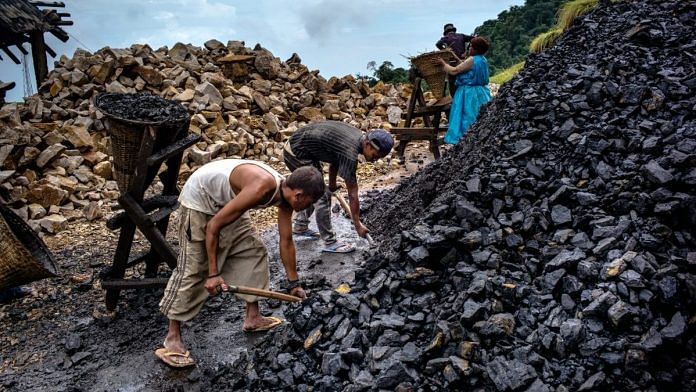New Delhi: The Parliament Monday cleared the Mines and Minerals (Development and Regulation) Amendment (MMRDA) Bill, 2021, which will help unshackle India’s vast mining reserves that lie untapped now.
The bill to regulate India’s mining sector was passed by Rajya Sabha. Once it becomes an act after getting presidential assent, it will help make the mining sector more industry friendly by doing away with a lot of restrictions in the existing law. In a first, the bill will also allow private entities to be engaged in mineral exploration work.
Introducing the bill in the Rajya Sabha, Coal and Mines Minister Pralhad Joshi said the amendments were necessitated because despite India’s immense mineral potential, the country is “under-explored” and “under-performed” in attracting investment. The bill, which was passed by the Lok Sabha last week, amends the Mines and Minerals (Development and Regulation) Act, 1957.
“India is the fourth largest reserve of coal, still we import coal. According to an assessment by the Geological Survey of India, we have around 500 million tonnes of gold but still we import 983 tonne of gold every year, which is worth around Rs 229 lakh crore,” Joshi said.
He added, “We share similar potential like South Africa and Australia, where their contribution to GDP is 7.5 per cent. Australia is at 7 per cent and South Africa is at 7 per cent whereas India is only 1.75 per cent,” Joshi said.
One of the main reasons for this, Joshi said is because only the government agencies like GSI, MECL or CMPDIL are engaged in mining. The private players do not have much of a presence.
“We want to bring even private players into it because we know that we have rich minerals. We have coal, we have gold, and we have silver. But, we are not able to bring them out. That is why we are bringing some changes in this (law). That is why we are trying to redefine exploration,” Joshi said.
The Union minister said the major objective is to generate employment. “It will help generate approximately 55 lakh direct and indirect employment,” he said.
ThePrint explains some of the key points of the MMRDA Bill and how this will help India.
Also read: These are the 18 sectors that have been identified as ‘strategic’ for India by Modi govt
Changed definition
To start with, the bill clearly defines mines as a legal entity, not just a physical entity.
A legal entity means lease. Earlier, when the lease of a mine expired, all the statutory clearances given to the lessee were transferred to the new lessee, selected through an auction. However, this came with a catch — the statutory clearances are valid for just two years, after which the lessee has to obtain fresh clearances all over again. This is a time consuming process.
The amended bill provides for seamless transfer of statutory clearances from one lessee to another, with the provision that such clearances remain valid throughout the duration of the lease.
“This will not cause any disruption. Some 904 mines will expire in the next 10 years … See the disruption it will cause if the new lessee has to obtain statutory clearances all over again,” BJP Rajya Sabha MP Ashwini Vaishnaw said while speaking on the bill.
No end-use restrictions on captive mines
The old law gave the central government the power to reserve any mine (except coal, lignite and atomic mineral) for a specified end use. These were called captive mines. The Centre could decide where production from such mines would be used.
The new bill has removed all such restrictions.
It also allows captive mines (except those mining atomic minerals) to sell 50 per cent of the mineral they produce in the open market. This was not allowed earlier. The new bill also empowers the Centre to auction a mine if the state government fails to do so within a specified timeframe.
Also read: All about commercial mining and how it changes the coal production game in India
Mining lease specifications
The amended bill mandates that once a mining lease has been given, production has to start within the next two years, otherwise the lease gets terminated.
It also provides for extending the mining lease given to government companies after the lease expires. This was not allowed earlier. This provision will go a long way in helping government public sector undertakings.
Easy transition from exploration to production
So far, if a company was given an exploration license and managed to find minerals, it had to apply afresh for getting a license for production from the mine. This clause has been removed now.
The new bill allows seamless transition from exploration to production.
Opposition’s counter
The bill has invited criticism from opposition parties including the Congress, who say that the bill tinkers with the federal structure of the Constitution.
Opposition leaders including Congress’s Jairam Ramesh in Rajya Sabha said that Clause 14(iii) that empowers the Centre to decide on auction a mine when the state government is unable to auction and Clause 10(i) that gives Centre the blanket power to determine composition and functioning of the District Mineral Foundation (DMF) is a complete mockery of the state government’s powers and responsibilities.
The DMF is to be utilised for the development of the district where the mine is located. Every mine owner is expected to contribute to the DMF. So far, the DMF has accumulated Rs 45,000 crore, of which just 45 per cent has been utilised.
The amended bill gives the central government blanket powers to decide the manner in which the DMF’s funds will be utilised.
(Edited by Manasa Mohan)
Also read: India’s use of coal power may have peaked in 2018, report says



